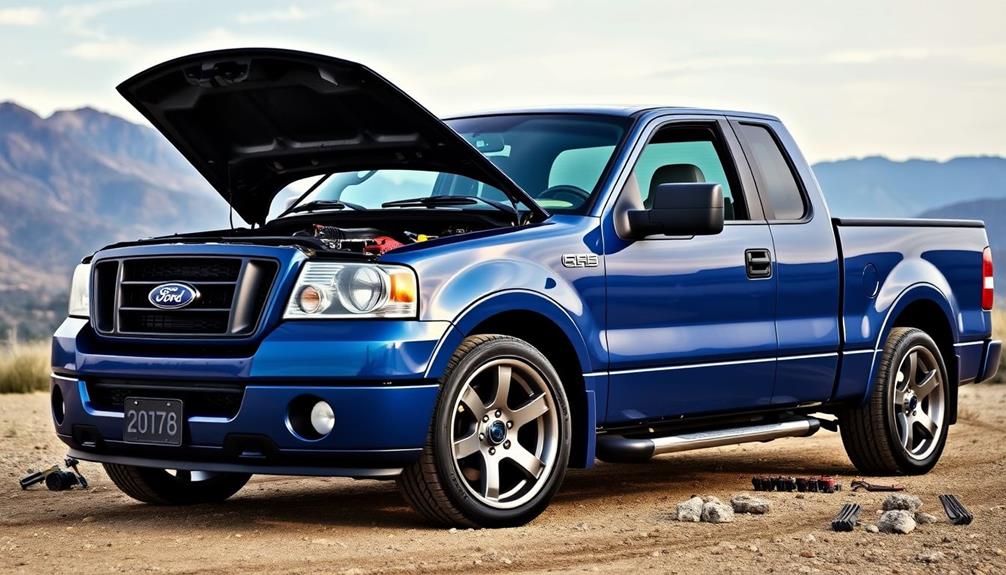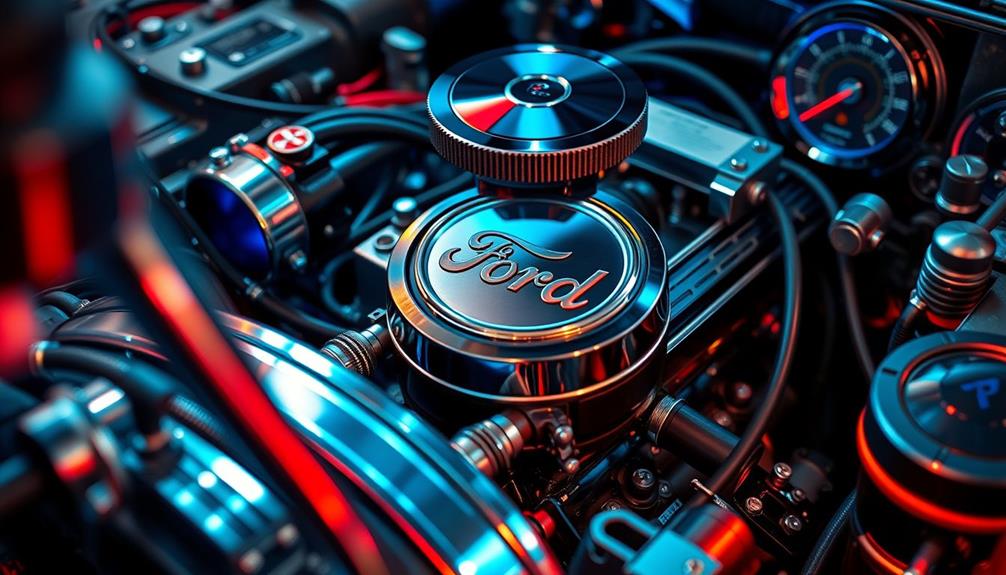Tuning your Ford F-150 is essential to maximizing its performance and releasing more horsepower and torque. Start with aftermarket tunes, like SCT X4 or 5Star, to enhance engine parameters, improve fuel efficiency, or achieve firmer shifts. Consider bolt-on modifications like cold air intakes, performance exhaust systems, and upgraded fuel injectors for significant gains. Don't forget about suspension enhancements for better handling and traction. Regular maintenance is vital too, ensuring your engine stays healthy post-modifications. With the right choices, you can transform your F-150 into a powerhouse. Keep exploring to uncover more tips for optimizing your truck's capabilities!
Key Takeaways
- Tuning modifications can enhance Ford F-150 performance by increasing horsepower and torque beyond the factory specifications.
- Aftermarket tunes, like SCT X4 and 5Star tunes, optimize engine parameters for better drivability and fuel efficiency.
- Cold air intakes and exhaust system upgrades significantly improve airflow and sound, yielding noticeable performance gains.
- Regular maintenance, including oil changes and air filter inspections, is essential to maintain engine integrity after modifications.
- Compliance with state emissions laws is crucial, as tuning may void warranties and affect vehicle legality.
Performance Mod Overview
When it comes to enhancing your Ford F-150's performance, tuning modifications play an essential role in maximizing your truck's capabilities. These performance modifications can greatly improve drivetrain efficiency, boosting horsepower and torque beyond the 2020 model's baseline of 395 HP and 400 ft-lbs.
As an F-150 owner, you'll find various tuning options available, such as 5Star tunes for safety, SCT X4 for all-encompassing adjustments, and custom tuning tailored to your specific driving style.
Aftermarket tunes can lead to noticeable improvements in power, firmer transmission shifts, and increased fuel efficiency, making them a worthwhile investment. However, you need to be cautious; while these tuning options can enhance your truck's performance, they might void your warranty and must comply with state emissions laws, especially in regions with stricter regulations.
Custom tuning sessions typically start around $500, and while there are additional costs for handheld tuners and potential dyno services, the long-term savings on fuel can help offset these initial expenses.
Engine Bolt-On Modifications

Many F-150 owners find that engine bolt-on modifications offer a straightforward way to boost performance without diving into complicated upgrades. One of the most popular options is installing a cold air intake, like the Roush Cold Air Intake, which can provide gains of up to 10 horsepower and 15 ft-lbs of torque for around $439.
Another effective bolt-on modification is upgrading the throttle body, which optimizes airflow into the engine, enhancing overall performance. Additionally, installing a performance exhaust system can greatly improve sound and power, with costs typically ranging from $250 to $1000 depending on the components you choose.
Don't forget about tuning devices like the SCT X4 Tuner, which lets you adjust engine parameters for a substantial boost in horsepower and drivability.
For those looking to sharpen throttle response, devices such as the Pedal Commander can minimize lag in electronic gas pedals and usually cost around $350.
These bolt-on modifications are ideal for maximizing your Ford F-150's performance while keeping things simple and efficient. With the right upgrades, you'll enjoy a more responsive and powerful driving experience.
Cold Air Intake Options

When you're looking to boost your Ford F-150's performance, cold air intake options can make a significant difference.
Brands like Roush and S&B offer impressive gains in horsepower and torque, but proper installation is key to revealing those benefits.
Let's explore the performance gains, popular brands, and important installation tips to help you make the right choice.
Performance Gains Overview
Upgrading your Ford F-150 with a cold air intake can deliver noticeable performance gains, enhancing both horsepower and torque. By replacing the factory airbox, a cold air intake allows cooler air into the engine, improving combustion efficiency.
This upgrade not only boosts horsepower but also enhances throttle response, making your truck feel more responsive on the road.
For instance, the Roush Cold Air Intake can provide an estimated gain of 10 horsepower and 15 ft-lbs of torque, priced around $439. Alternatively, the S&B Cold Air Intake offers 40% better airflow compared to stock and comes in at $349, featuring a reusable filter that F-150 enthusiasts have highly rated.
Investing in a performance cold air intake is a cost-effective way to amplify your truck's horsepower and torque, especially when paired with other tuning mods.
Proper installation is essential, as it can greatly impact overall engine performance. With these enhancements, you'll experience a noticeable difference in your F-150's performance, making it a worthwhile upgrade for any enthusiast looking to maximize their ride's potential.
Popular Intake Brands
If you're looking to boost your Ford F-150's performance, exploring popular cold air intake brands can lead you to some impressive options. Each brand offers unique benefits to enhance your truck's horsepower and overall efficiency.
The Roush Cold Air Intake is a solid choice, providing an estimated gain of 10 horsepower and 15 ft-lbs of torque for around $439.
If you're after superior airflow, the S&B Cold Air Intake delivers 40% better airflow than stock systems, priced at $349 with a reusable filter that saves you money in the long run.
For those prioritizing durability, the K&N Cold Air Intake is formidable, boasting up to 50% more horsepower than factory intakes and a million-mile warranty.
The Airaid Cold Air Intake stands out for its easy installation while improving airflow and performance, yielding gains of 10-15 horsepower.
Installation Considerations
Installing a cold air intake on your Ford F-150 can greatly enhance performance, but there are important considerations to keep in mind.
First, look for options that offer installation ease. Both the Roush and S&B cold air intakes feature a straightforward bolt-on design, making DIY installation a breeze. You won't need specialized tools or extensive mechanical knowledge, which is a huge plus for many truck owners.
When you replace the factory airbox, you'll notice improved airflow to the engine, leading to enhanced throttle response and overall driving experience.
For example, the S&B intake provides 40% better airflow than stock options, which contributes to its impressive performance.
To maximize the benefits of your new cold air intake, consider complementary modifications like tuning. This helps optimize the engine's performance parameters to match the increased airflow, ensuring you get the most out of your investment.
Whether you choose the Roush or S&B, both options promise to deliver better engine response and efficiency, making your F-150 not only more powerful but also a joy to drive.
Tuning Methods and Insights

Exploring tuning methods for the Ford F-150 opens up a world of possibilities for enhancing your truck's performance. You can choose between DIY options, like handheld tuners such as the SCT X4, or go for professional custom tuning sessions, which often start at around $500. If you’re not comfortable doing the tuning yourself, it might be worth looking for ford tuning specialists near me to ensure the job is done right. These professionals have the knowledge and expertise to optimize your truck’s performance and efficiency. They can also provide personalized recommendations based on your specific driving habits and goals for your F-150.
A performance tune, such as the 93 Octane option from MPT, can greatly improve your engine response and fuel efficiency tailored to your driving style. Additionally, understanding your investment regulations can help you make informed financial decisions regarding your tuning budget.
For the best results, consider dyno tuning, which allows for precise adjustments to engine parameters, ensuring you achieve peak performance without sacrificing reliability. Many users report firmer transmission shifts and increased MPG after proper tuning, making it a wise investment.
When diving into tuning methods, it's essential to choose reputable tuning shops. Community feedback often highlights the considerable performance gains that come from expert custom tuning.
Whether you're aiming for more power or improved drivability, the right tuning strategy can transform your Ford F-150 into a true powerhouse on the road. Make informed choices to reveal your truck's full potential!
Exhaust Modification Benefits

Upgrading your Ford F-150's exhaust system can bring significant benefits, enhancing both performance and sound. One of the key exhaust modification benefits is the potential for horsepower gains of 10-20%, depending on your specific setup. By installing performance headers, you can reduce restrictions and improve engine efficiency, allowing your truck to breathe better.
Cat-back exhaust systems are another popular option, replacing the factory exhaust from the catalytic converter back. This modification not only enhances sound quality but also reduces weight, contributing to better overall performance.
Quality systems made from durable materials like stainless steel guarantee that your upgrades last longer and resist corrosion, while also providing that aggressive sound profile many enthusiasts crave.
Investing in these modifications typically costs between $250 to $1000, with an average around $500. This investment yields considerable performance enhancements and a more enjoyable driving experience.
With improved exhaust flow and reduced restrictions, you'll notice increased responsiveness, making your Ford F-150 not just more powerful, but also a pleasure to drive.
Suspension Upgrades for Performance

Enhancing your Ford F-150's suspension can revolutionize your driving experience, particularly if you're tackling off-road adventures.
Suspension upgrades can greatly improve handling and stability, making your truck feel more responsive and controlled on any terrain. Investing in upgraded shocks and springs is a solid first step.
Consider adding traction bars to manage power delivery from the engine. They enhance grip during acceleration and notably reduce wheel hop, providing you with a smoother ride.
If you're looking to improve aesthetics and handling, lowering kits like IHC Lowering Kits can lower your truck's center of gravity while maintaining ride quality.
For those who want versatility, adjustable suspension options let you customize your F-150's ride height and stiffness. This way, you can optimize performance based on your specific driving needs or conditions.
Quality suspension modifications, such as VA Specialties double adjustable coilovers, can enhance overall driving comfort without sacrificing performance.
Fuel System Enhancements

When you're looking to boost your Ford F-150's performance, upgrading your fuel injectors is a must.
Enhanced fuel delivery systems not only support increased power demands but also guarantee your engine runs smoothly under high loads.
Upgraded Injector Benefits
One of the key benefits of upgraded injectors in your Ford F-150 is their ability to meet the increased fuel flow demands of modified engines. When you enhance your engine's performance, whether through tuning or physical upgrades, your fuel system needs to keep up. Upgraded injectors provide the necessary fuel volume, ensuring your engine operates efficiently during high-load situations.
By improving fuel atomization, these performance injectors can greatly boost horsepower and torque output, making your ride more responsive and enjoyable. Maintaining the correct air-fuel ratio is vital, especially in high-performance setups, and upgraded injectors excel at this.
You'll find a range of aftermarket injector kits tailored to various power levels, allowing you to customize your setup based on specific engine modifications. Properly matched injectors not only optimize performance but also enhance reliability by preventing lean conditions that can cause engine damage.
In short, investing in upgraded injectors is essential for maximizing your Ford F-150's capabilities, ensuring both impressive power and dependable performance on the road.
Enhanced Fuel Delivery Systems
Upgraded injectors are just one part of the equation for achieving peak performance in your Ford F-150. To truly maximize your truck's potential, consider a complete fuel system upgrade. This involves not just replacing the injectors but also installing aftermarket fuel pumps that can support higher fuel flow rates. Enhanced performance hinges on ensuring your engine receives the right amount of fuel, especially during demanding driving conditions.
By upgrading your fuel delivery system, you'll markedly improve engine efficiency. Properly sized fuel lines play a vital role in preventing pressure drops, ensuring ideal fuel delivery to the engine.
When you combine upgraded fuel injectors with a reliable aftermarket fuel pump, your Ford F-150 models will experience notable gains in power and responsiveness.
There are many aftermarket kits available specifically designed for Ford F-150 models, making it easier for you to boost your engine performance effectively.
Whether you're aiming for better acceleration or improved towing capacity, investing in enhanced fuel delivery systems will get you there. Don't overlook these key components when planning your performance upgrades; they're essential for releasing your truck's full potential.
Supporting Increased Power Demands
Supporting increased power demands in your Ford F-150 requires a robust fuel system that can handle the stress of performance upgrades like superchargers. Upgraded fuel pumps are essential, guaranteeing reliable fuel delivery during high-performance situations. You don't want to experience fuel starvation when you're pushing your truck to its limits.
Enhanced fuel injectors also play an important role by providing the necessary fuel flow to match the increased horsepower from your modifications. This guarantees your engine operates efficiently, maximizing its performance and longevity.
With proper fuel system enhancements, you can expect significant improvements in overall engine performance, particularly under heavy loads.
Consider investing in aftermarket fuel system kits specifically designed for high-performance F-150 models. These kits enhance fuel delivery and boost engine efficiency, allowing your truck to perform at its best.
By upgrading your fuel system, you're not just preparing for more power; you're also guaranteeing that your engine can handle that power effectively.
Ultimately, a well-tuned fuel system is essential for achieving peak fuel delivery, keeping your F-150 running strong and reliable, even in demanding conditions.
Engine Protection Strategies

Effective engine protection strategies are fundamental for maximizing the lifespan and performance of your Ford F-150, especially if you've made modifications. One key component to take into account is the installation of an oil catch can, like the UPR Dual Valve Catch Can. This device prevents harmful oil and contaminants from entering the intake manifold, greatly reducing carbon build-up and enhancing engine longevity.
Regular maintenance plays a critical role in maintaining ideal performance. Be sure to clean the mass airflow sensor and throttle body regularly, as these components directly affect engine efficiency.
Additionally, using high-quality oil and changing it often is essential to uphold engine integrity, particularly after major modifications that can increase wear.
Upgrading to a performance-oriented fuel system guarantees reliable fuel delivery under heavy load, which is crucial for supporting the heightened horsepower demands from your performance upgrades.
Finally, implementing a routine inspection of your engine components can help you catch potential issues early, preventing costly repairs and guaranteeing peak engine performance.
Prioritize these engine protection strategies, and you'll enjoy a powerful and long-lasting F-150.
Aesthetic and Functional Modifications

After ensuring your engine's protection, it's time to focus on the aesthetic and functional modifications that can elevate your Ford F-150.
Start with upgraded headlights and fog lights; they enhance visibility and safety during nighttime and adverse weather, boosting both aesthetic appeal and functionality. Consider adding LED lighting options, which provide brighter illumination and improve off-road performance while looking sleek.
Additionally, incorporating features from modern designs, such as a dual-flush toilet system, can inspire innovative upgrades that optimize efficiency in other aspects of your truck.
Custom grilles and hoods not only reflect your personal style but can also enhance airflow and cooling, contributing to overall vehicle performance. Quality lighting modifications, such as upgraded third brake lights, can increase visibility to drivers behind you, ensuring safety on the road.
Don't overlook body modifications that can considerably alter your truck's appearance. Aerodynamic enhancements may improve fuel efficiency, making your F-150 stand out while also being more efficient on fuel.
Maintenance Tips for Longevity

To keep your Ford F-150 running strong, regular oil changes are essential.
Don't forget to clean or replace your air filters and inspect the cooling system, too; these steps play a significant role in maintaining engine efficiency.
Staying on top of these maintenance tasks will help you enjoy your truck for years to come.
Regular Oil Changes
Regular oil changes are essential for keeping your Ford F-150's engine running smoothly and efficiently. Most experts recommend changing your oil every 5,000 to 7,500 miles, using high-quality synthetic oil for peak performance. This practice not only supports engine health but also helps prevent contaminants from circulating, which can lead to increased engine wear.
Each time you change your oil, make sure to replace the oil filter as well. This step is vital in removing dirt and debris that could compromise your engine's longevity and efficiency. Neglecting regular oil changes can result in dirty oil that loses its lubricating properties, leading to reduced fuel economy and potentially costly repairs down the line.
For instance, maintaining the oil in your 2020 Ford F-150 5.0L engine can help you keep that impressive baseline performance of 395 HP and 400 ft-lbs of torque.
Regularly monitoring oil levels and quality allows you to catch any issues early, ensuring timely maintenance that enhances overall engine longevity.
Prioritize your oil changes—it's one of the simplest yet most effective ways to protect your investment.
Clean Air Filters
Keeping your Ford F-150's air filter clean is vital for maintaining ideal engine performance. Regular maintenance of clean air filters guarantees optimal airflow to the engine, which directly impacts throttle response and fuel efficiency.
It's recommended to check your air filter every 15,000 to 30,000 miles, but if you often drive in dusty or polluted environments, you may need to inspect it more frequently. Additionally, verifying that your vehicle is free from allergens and other irritants can contribute to a healthier driving experience, much like how natural remedies alongside conventional medications can support overall well-being.
Clogged air filters hinder airflow, leading to decreased horsepower and increased fuel consumption—sometimes by as much as 10%. By replacing or cleaning your filter regularly, you can avoid these issues and keep your F-150 performing at its best.
Consider upgrading to a high-quality aftermarket air filter, such as a reusable cotton or foam filter, for improved filtration and airflow compared to standard paper filters.
Investing time in air filter maintenance not only enhances engine performance but also contributes to overall vehicle longevity. Remember, clean air filters are a simple yet effective way to guarantee your F-150 continues to deliver the horsepower and efficiency you expect.
Don't overlook this vital aspect of your truck's maintenance routine!
Inspect Cooling System
Maintaining your Ford F-150's cooling system is just as important as guaranteeing clean air filters. Start by regularly checking the coolant level and its condition. Keeping it at the recommended level helps prevent overheating and maintains engine efficiency.
Next, inspect hoses and connections for any signs of wear, leaks, or corrosion; these issues can compromise the cooling system's effectiveness.
It's also vital to flush the cooling system every 30,000 miles, or as recommended by the manufacturer. This process removes contaminants and prevents sludge buildup, which can hinder heat transfer.
Additionally, test the thermostat to verify it opens and closes at the right temperature. A functioning thermostat regulates coolant flow, preventing overheating.
Don't forget to monitor the radiator for blockages or damage. Proper airflow is essential for maintaining peak engine temperatures during operation.
By regularly checking and maintaining these components, you'll enhance your F-150's performance and longevity. Taking the time to inspect your cooling system can save you from costly repairs down the line.
Stay proactive, and you'll keep your truck running smoothly for years to come.
Frequently Asked Questions
How Can I Improve My F-150 Performance?
To improve your F-150's performance, consider upgrading to a cold air intake, installing a performance exhaust system, and tuning with a quality device. These modifications can greatly enhance horsepower, torque, and overall driving experience.
What Is the Best Tune for the F-150 Ecoboost?
You'll feel like you've released a beast! For your F-150 Ecoboost, consider Unleashed tunes via SCT X4 for lightning-fast response, or MPT's 93 Octane tune for an exhilarating boost in power and drivability.
How Do I Get More Power Out of My 5.0 F-150?
To get more power out of your 5.0 F-150, consider upgrading to a cold air intake, installing a performance exhaust, and utilizing a tuner for custom settings. These modifications can greatly boost horsepower and performance.
What Is Included in a Ford F-150 Tune Up?
When you pamper your Ford F-150 with a tune-up, you'll check and replace spark plugs, inspect the fuel system, clean air filters, and guarantee the ignition components are in top shape for peak performance.
Conclusion
To sum up, tuning your Ford F-150 can release its full potential, making it the powerhouse you've always wanted. Whether you're bolting on new parts or tweaking the engine's brain, every upgrade counts. Remember, it's not just about horsepower; it's about creating a ride that turns heads while you cruise down the highway like it's 1999. Keep your truck well-maintained, and you'll enjoy every mile. Now, go ahead and make that truck truly yours!










